Asthma Control Program
Publications
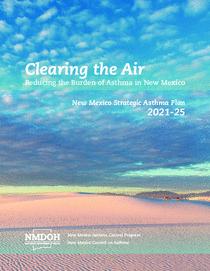 Clearing the Air – Reducing the Burden of Asthma in New Mexico 2021-2025
Asthma - Plan
March 16, 2021
Clearing the Air – Reducing the Burden of Asthma in New Mexico 2021-2025
Asthma - Plan
March 16, 2021
Clearing the Air – Reducing the Burden of Asthma in New Mexico 2021-2025
 Asthma Pictorial Action Plan
Asthma - Form
February 12, 2019
Asthma Pictorial Action Plan
Asthma - Form
February 12, 2019
The pictorial asthma action plan is a patient education tool intended to supplement the asthma action plan. It is designed to engage children and families in asthma self-management and improve overall measures of asthma control.
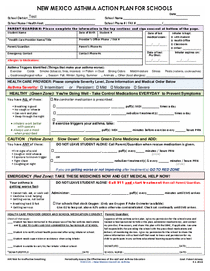 Asthma Action Plan for Schools
Asthma - Form
February 12, 2019
Asthma Action Plan for Schools
Asthma - Form
February 12, 2019
This action plan form was created by the New Mexico Council on Asthma (NMCOA) for school nurses, health care providers and families. It allows for an individual action plan to be developed for each student to ensure proper handling of asthma based on severity.
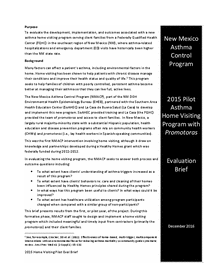 Asthma Home Visiting Program with Promotoras 2015
Asthma - Report
March 21, 2017
Asthma Home Visiting Program with Promotoras 2015
Asthma - Report
March 21, 2017
The purpose was to evaluate the development, implementation, and outcomes associated with a new asthma home visiting program serving client families from a Federally Qualified Health Center in the southeast region of New Mexico, where asthma-related hospitalizations and emergency department visits have historically been higher than the New Mexico state rate.
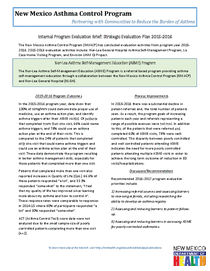 Asthma Strategic Evaluation Plan 2015-2016
Asthma - Report
March 21, 2017
Asthma Strategic Evaluation Plan 2015-2016
Asthma - Report
March 21, 2017
The New Mexico Asthma Control Program has concluded evaluation activities from program year 2015-2016. Evaluation activities include: Nor-Lea General Hospital Asthma Self-Management Program, La Casa Home Visiting Program, and Envision University of New Mexico Quality Improvement Project.
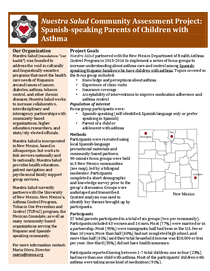 Spanish-speaking Parents of Children with Asthma
Asthma - Report
March 21, 2017
Spanish-speaking Parents of Children with Asthma
Asthma - Report
March 21, 2017
Nuestra Salud partnered with the New Mexico Department of Health Asthma Control Program in 2015-2016 to implement a series of focus groups to increase understanding about asthma care and control among Spanish-speaking Hispanic families who have children with asthma.
 Asthma Control Program Logic Model
Asthma - General
May 11, 2015
Asthma Control Program Logic Model
Asthma - General
May 11, 2015
The Logic Model is a Program Evaluation tool. It helps project partners see how the resources and activities of the NMACP program connect and contribute to desired health outcomes.
 NMCOA Evaluation of Meetings & Attendance
Asthma - Meeting
June 5, 2014
NMCOA Evaluation of Meetings & Attendance
Asthma - Meeting
June 5, 2014
This document provides an evaluation of meetings and attendance for all New Mexico Commission on Asthma (NMCOA) meetings held and is updated periodically. It provides a list of commonly held credentials and affiliations, number of meetings, number of participants who have attended, attendees per meeting, and annual averages for attendance.
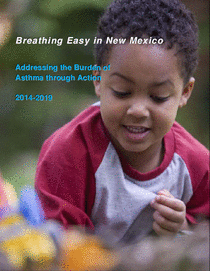 Breathing Easy in New Mexico: Addressing the Burden of Asthma through Action 2014-2019
Asthma - Plan
April 25, 2014
Breathing Easy in New Mexico: Addressing the Burden of Asthma through Action 2014-2019
Asthma - Plan
April 25, 2014
Asthma is a widespread and serious health condition, particularly for children, which requires regular and consistent health care to control. The NMCOA is poised to improve asthma care and outcomes in the state through professional and community outreach. This document highlights the work of the NMCOA to date, the current state of asthma in New Mexico, goals and objectives for the next five years.
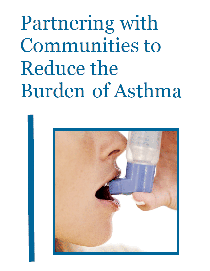 Asthma Brochure
Asthma - Marketing
April 1, 2014
Asthma Brochure
Asthma - Marketing
April 1, 2014
This double-sided tri-fold brochure explains general information about our asthma program including statistics, contact information, and a list of website resources to learn more about asthma.
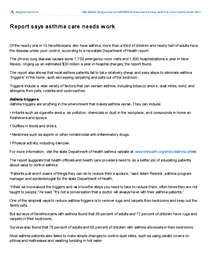 Report Says Asthma Care Needs Work
Asthma - General
February 20, 2014
Report Says Asthma Care Needs Work
Asthma - General
February 20, 2014
Of the nearly one in 10 New Mexicans who have asthma, more than a third of children and nearly half of adults have the disease under poor control, according to a new state Department of Health report. The chronic lung disease causes some 7,700 emergency room visits and 1,800 hospitalizations a year in New Mexico, ringing up an estimated $30 million a year in hospital charges, the report found.
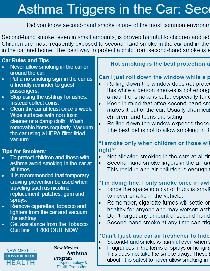 Asthma Triggers in the Car Fact Sheet
Asthma - Help
May 6, 2013
Asthma Triggers in the Car Fact Sheet
Asthma - Help
May 6, 2013
Second-hand smoke, even in small amounts, is proven harmful to children and adults. It can bring on an asthma episode. Children are most frequently exposed to second-hand smoke in the car and in the home. A top protection is to eliminate tobacco in the car and home. The best way to protect a child from second-hand smoke is eliminating smoking in the car and home.
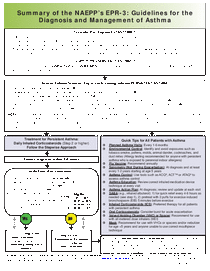 Guidelines for Diagnosis & Management of Asthma
Asthma - Guide
October 16, 2012
Guidelines for Diagnosis & Management of Asthma
Asthma - Guide
October 16, 2012
This guideline is based on the recommendations from the NAEPP EPR-3 and is intended to assist the clinician in the diagnosis and management of asthma and should not be construed as a replacement for individualized evaluation and treatment based on clinical circumstances.
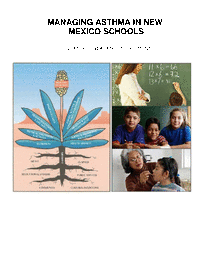 Managing Asthma in New Mexico Schools
Asthma - Guide
May 16, 2012
Managing Asthma in New Mexico Schools
Asthma - Guide
May 16, 2012
It is our hope and expectation that school districts will use this manual as a guide to enlist the cooperation of all members of the school community. The sections on Asthma (3), the Student with Asthma (4), and the Asthma Friendly School (5) provide general information useful to all members of the community. The remaining sections (6-14) contain more specific information pertinent to individual members of the community. Finally section 15 lists a variety of helpful resources for everyone's use.
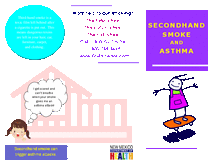 Second-Hand Smoke and Asthma Fact Sheet
Asthma - Help
January 1, 2011
Second-Hand Smoke and Asthma Fact Sheet
Asthma - Help
January 1, 2011
This fact sheet explains how secondhand and third-hand smoke effects asthma, how tobacco smoke can trigger an asthma attack, how to protect yourself and your children, and provides tips on how to politely ask someone not to smoke around you.

